The State of Django 2024
Are you curious to discover the latest trends in Django development?
In collaboration with the Django Foundation, PyCharm surveyed more than 4,000 Django developers from around the globe and analyzed the trends in framework usage based on their answers.
In this blog post, we share the following key findings with you:
- Every third Django developer also uses Flask or FastAPI.
- Most developers use Django for both full-stack and API development.
- 61% of Django developers use asynchronous technologies.
- And many more insights!
Dive in to learn about these findings in more detail and discover other trends in Django development, while also benefiting from illustrative infographics.

Backend: Every third Django developer also uses Flask or FastAPI
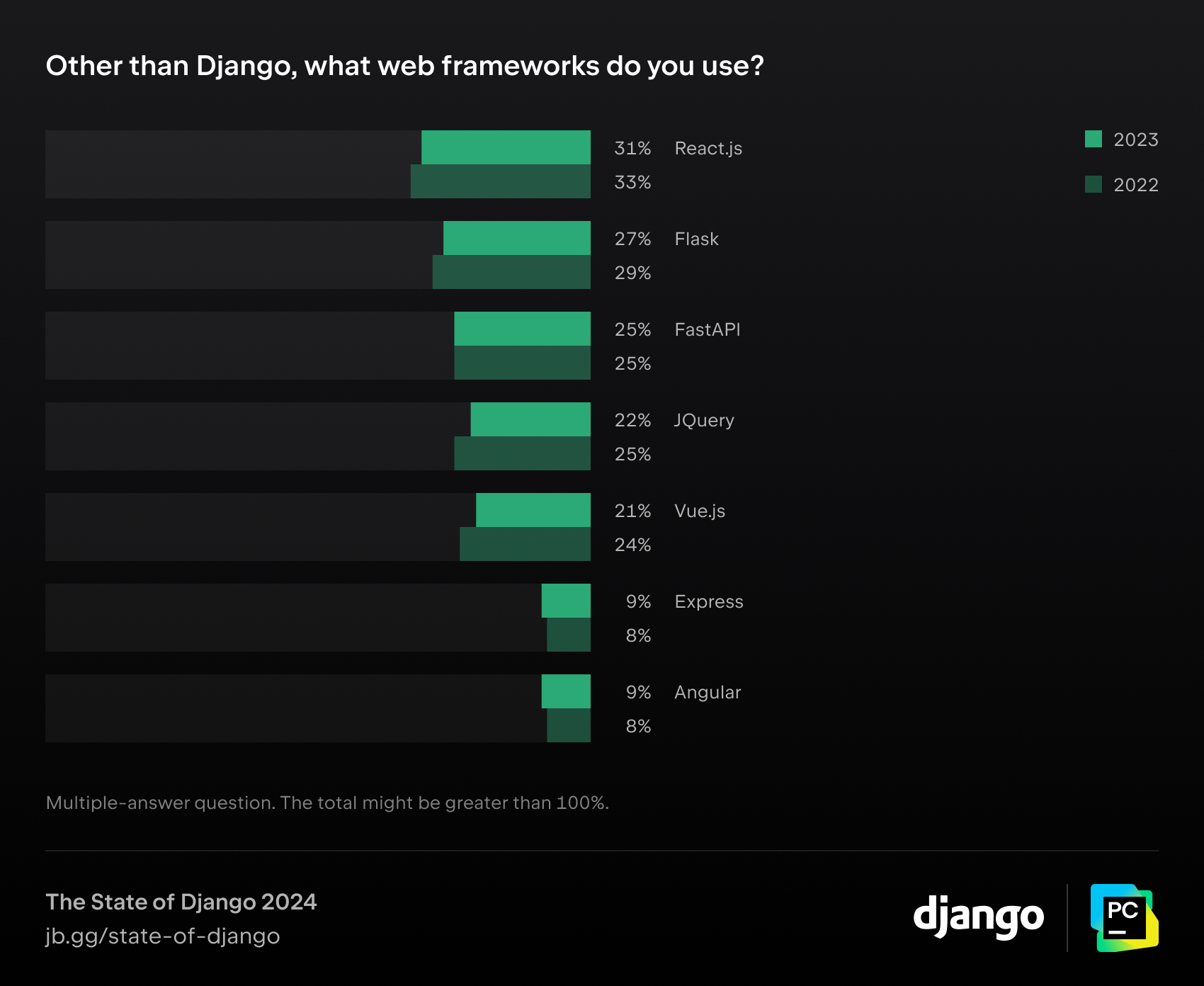
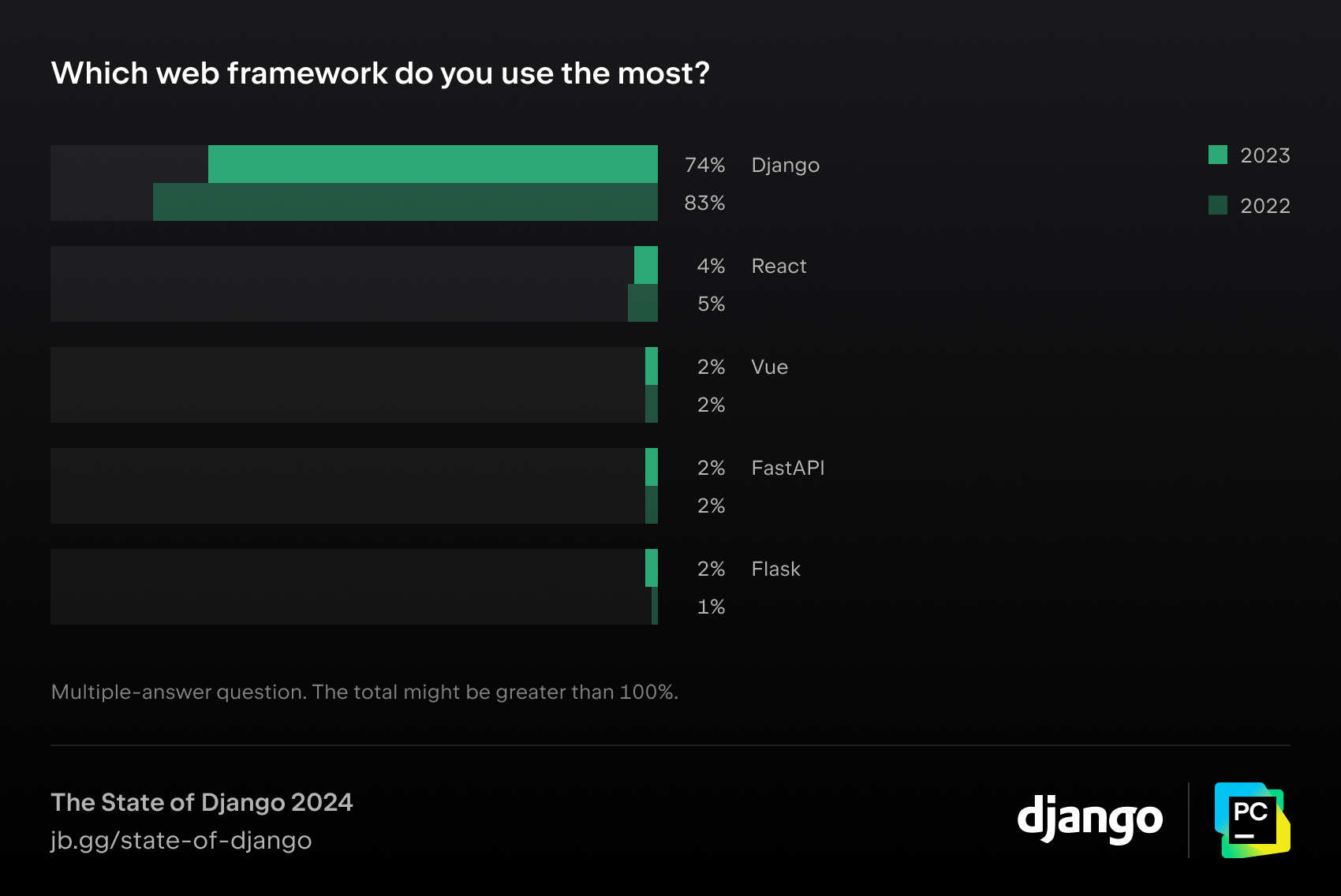
Django remains the go-to framework for 74% of developers, though this does represent a minor dip from last year when this figure stood at 83%. FastAPI has managed to maintain its popularity, as 25% of respondents reported using it. Meanwhile, Flask saw a slight decline in popularity (29% in 2022 to 26% in 2023).
33% of web developers who work primarily with Django also use Flask or FastAPI, showing diverse backend skills.
Taking into account that the majority of fully employed developers (49%) report working on several projects at the same time, this may indicate that they choose different tools for different purposes:
- Django – for larger, more complex web apps due to its “batteries included” approach.
- Flask – for simpler applications (especially static sites) or microservices.
- FastAPI – to create API endpoints, especially if your application includes a lot of IO calls (especially for real-time web applications).
The fact that only 11% of all Django developers use all three frameworks might mean that most of them use Flask and FastAPI for similar purposes, shifting to FastAPI due to its async capabilities.
Want to learn how Django is different from Flask and FastAPI? Check out our detailed comparisons between Django and Flask, and Django and FastAPI to see which framework will best suit your needs.
Developing APIs: Most developers use Django for both full-stack and API development
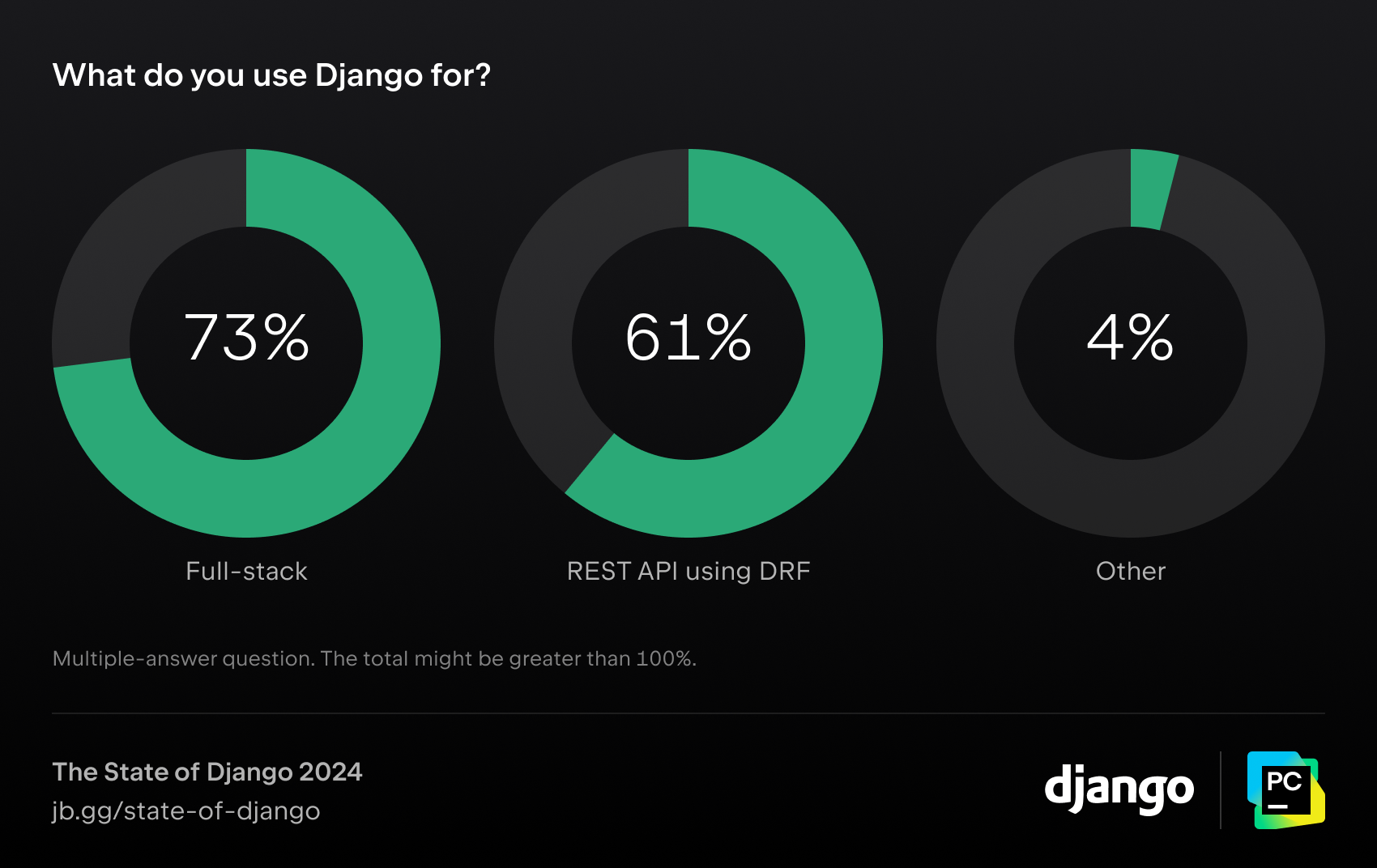
This year’s survey revealed Django is popular for both full-stack (74%) and API development (60%), with a trend towards API work among fully employed devs. Fully employed developers are more likely to use Django for REST API development (65% vs. 60% on average), but less likely to use it for full-stack development (68% vs. 74% on average).
With the rising popularity of htmx, the trend might change in favor of using Django more for full-stack development.
Interestingly, while DRF has retained the pole position among third-party packages, its popularity dipped as Django Ninja, known for its speed and typing capabilities, continues to gain ground. Django Ninja offers high performance and asynchronous capabilities, similar to another very popular choice for creating APIs, FastAPI, but within the Django ecosystem, which makes the learning curve shorter.
Work with APIs? Read this tutorial to learn how to build APIs with the Django REST framework.
Async: 61% of Django developers use async
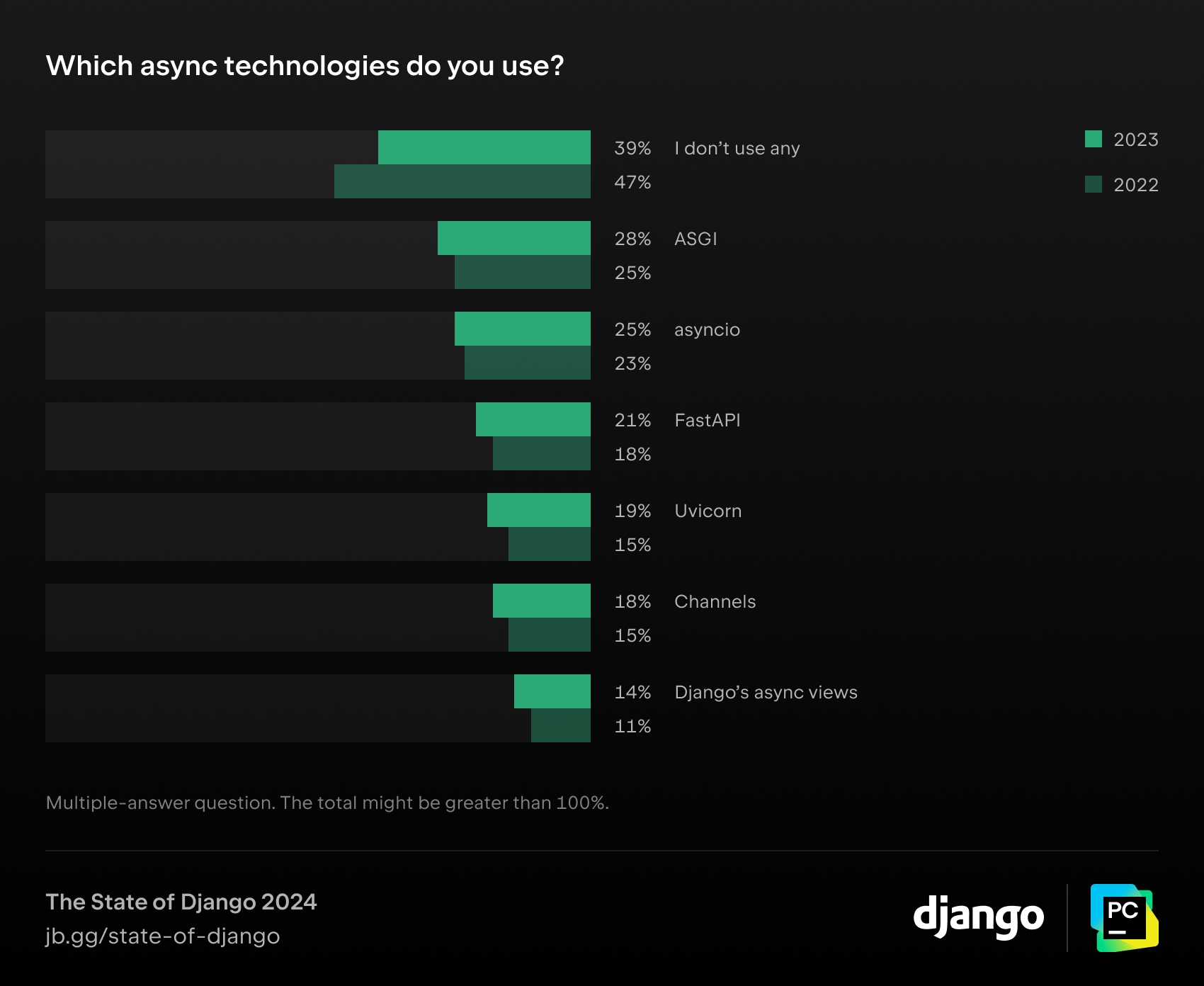
There’s a clear transition towards using asynchronous technologies among Django developers, with 61% now incorporating async in their projects (up from 53% last year).
FastAPI, which was built with async programming in mind, is now used by 21% of all Django developers who use async technologies. Django async views are also being used by more respondents (14%), though FastAPI is still more popular for async tasks. With more async support planned for upcoming Django 5 releases, the interest in using async in Django might increase even more.
Frontend: a shift in Django developers’ preferences towards htmx, Alpine.js, and Tailwind CSS
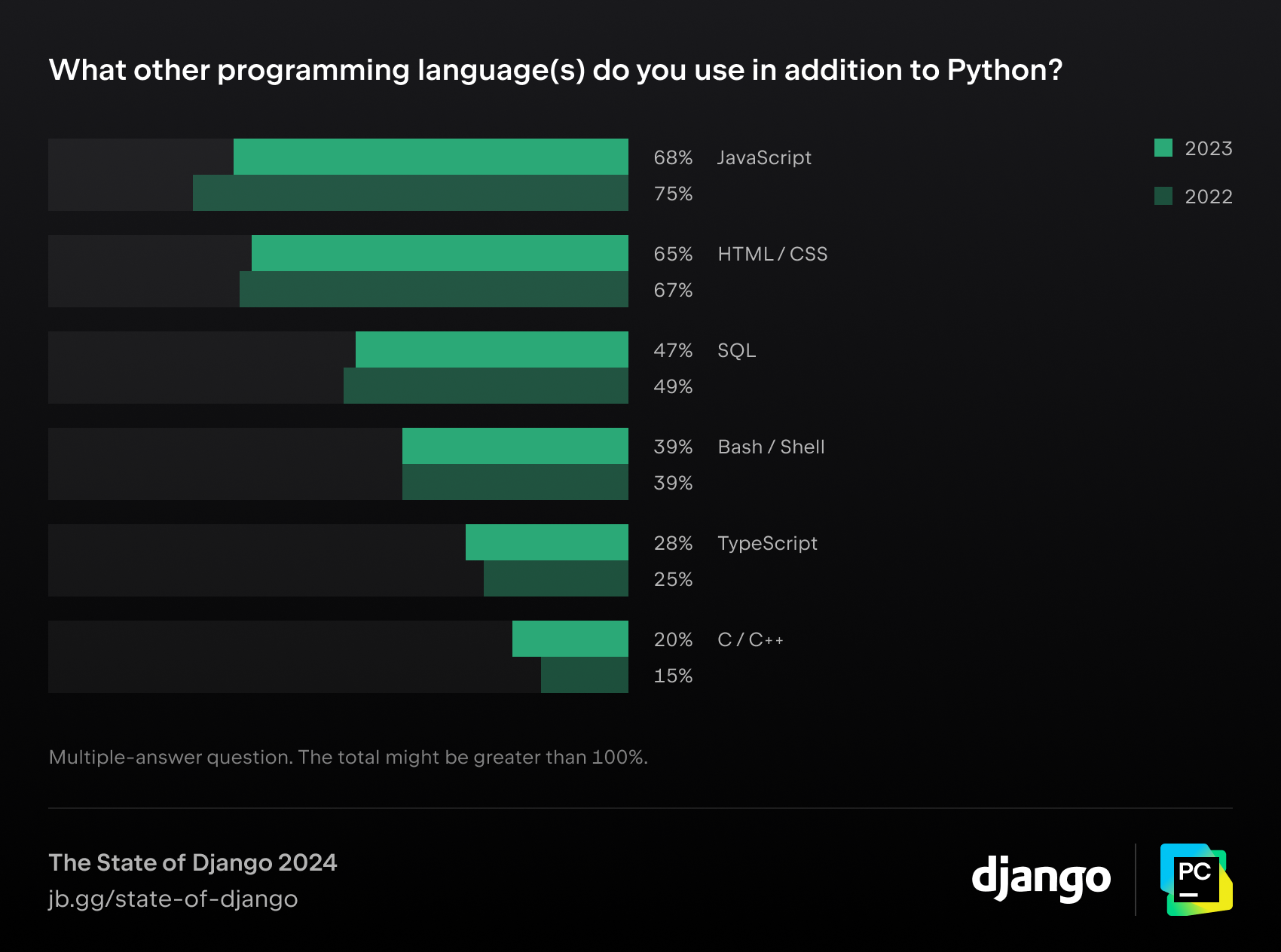
When it comes to frontend, JavaScript is still the most popular language, with 68% of developers stating that they use it. That said, it’s gradually conceding its comfortable lead (75% in 2021 and 2022) to TypeScript, which has grown significantly from 19% in 2021 to 28% in 2023. This increase in popularity is probably attributable to its static typing features, which help catch errors early in the development process and thus make code more robust and maintainable.

Professional Django developers still clearly favor JavaScript frameworks over their competitors, with usage rates of 26% for Vue, 35% for jQuery, and 42% for React, though their overall use is declining year over year.
Newer frameworks like htmx (which grew from 16% in 2022 to 23% in 2023) and Alpine.js (which grew from 6% to 10%) are rapidly gaining traction, suggesting a shift towards simpler tools for modern user interfaces. There is a dedicated django-htmx package developed by Adam Johnson.
Dennis Ivy on htmx:
“Happy to see HTMX here. I’m not the biggest fan (I default to React) but I think it’s suitable for many Django projects that need a little flexibility without having to move to a full fledged JS framework/library.”
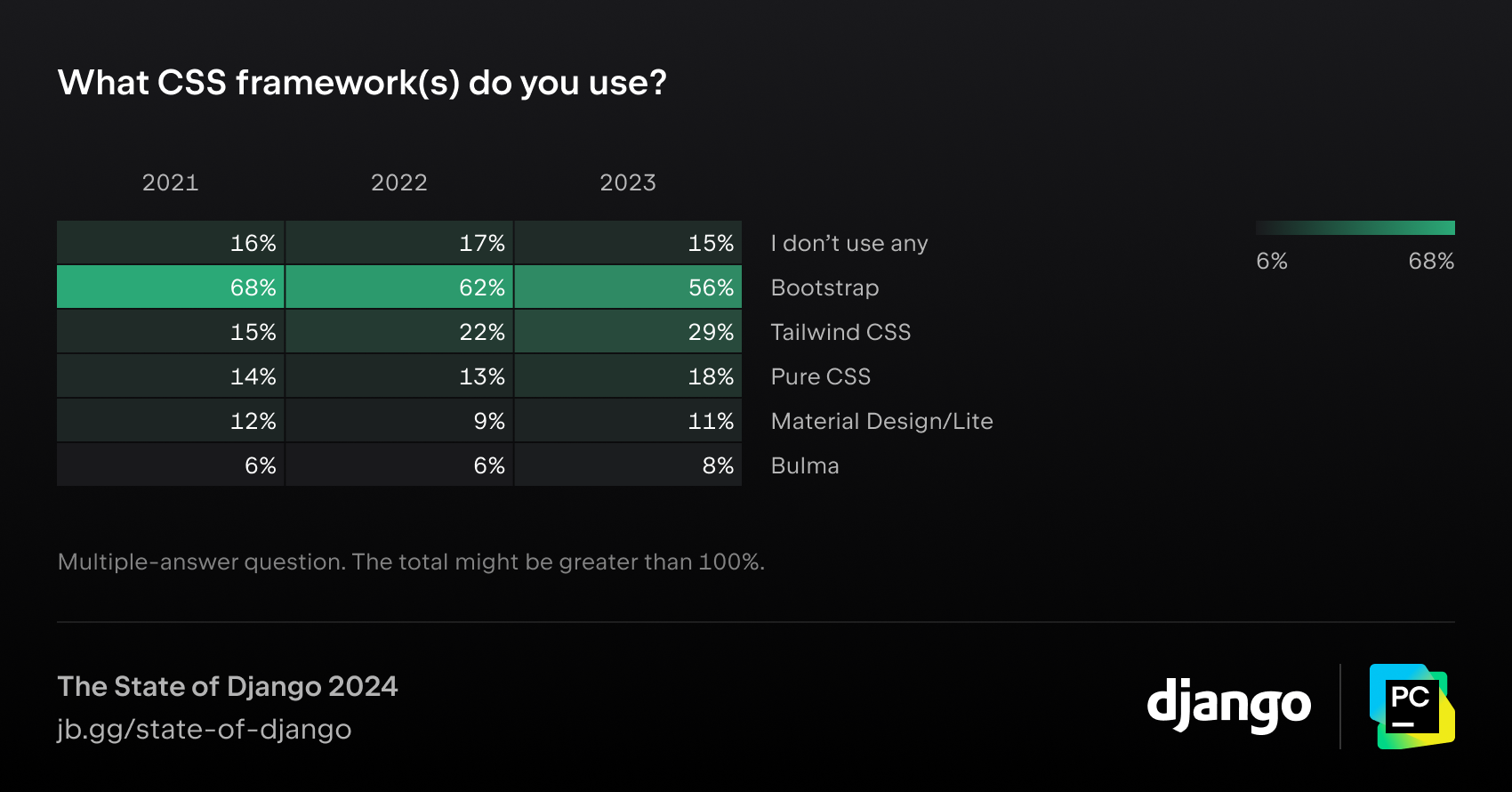
We continue to see a downward trend for Bootstrap and significant growth for Tailwind CSS, whose popularity has doubled in the last two years. The increasing preference for Tailwind CSS over Bootstrap suggests a desire for more customizable and less prescriptive approaches to styling in web projects. Read this article from package creator Tim Kamanin for a guided introduction to using Tailwind CSS in Django.
Dennis Ivy on TailwindCSS:
“Love to see the rise of Tailwind-Django usage. Hope to see more native integration and educational content in this area.”
Databases: 75% of Django developers favor PostgreSQL, and 50% rely on Redis for caching

In the Django ecosystem, PostgreSQL leads the pack as the primary database choice (76%) among developers, highlighting the preference for robust, SQL-based systems for web applications. The interest in NoSQL databases like MariaDB (10%) and MongoDB (8%) is also notable, reflecting a diversifying database landscape.
The inclusion of the schema-less and scalable MongoDB among the top database choices, despite its lack of official Django support, reflects developers’ willingness to integrate more flexible, document-oriented databases.
Do you work with MongoDB? Read this step-by-step guide on how to connect Django with MongoDB.
Dennis Ivy on MongoDB:
“This number surprises me considering the different approach Mongo takes and the incompatibility with Django. Curious to know the experience level of those 8%. I would suspect that those are newer devs and / or devs running experimental projects.
After speaking to several MongoDB team members I was able to conclude my thoughts on this integration in an article.”
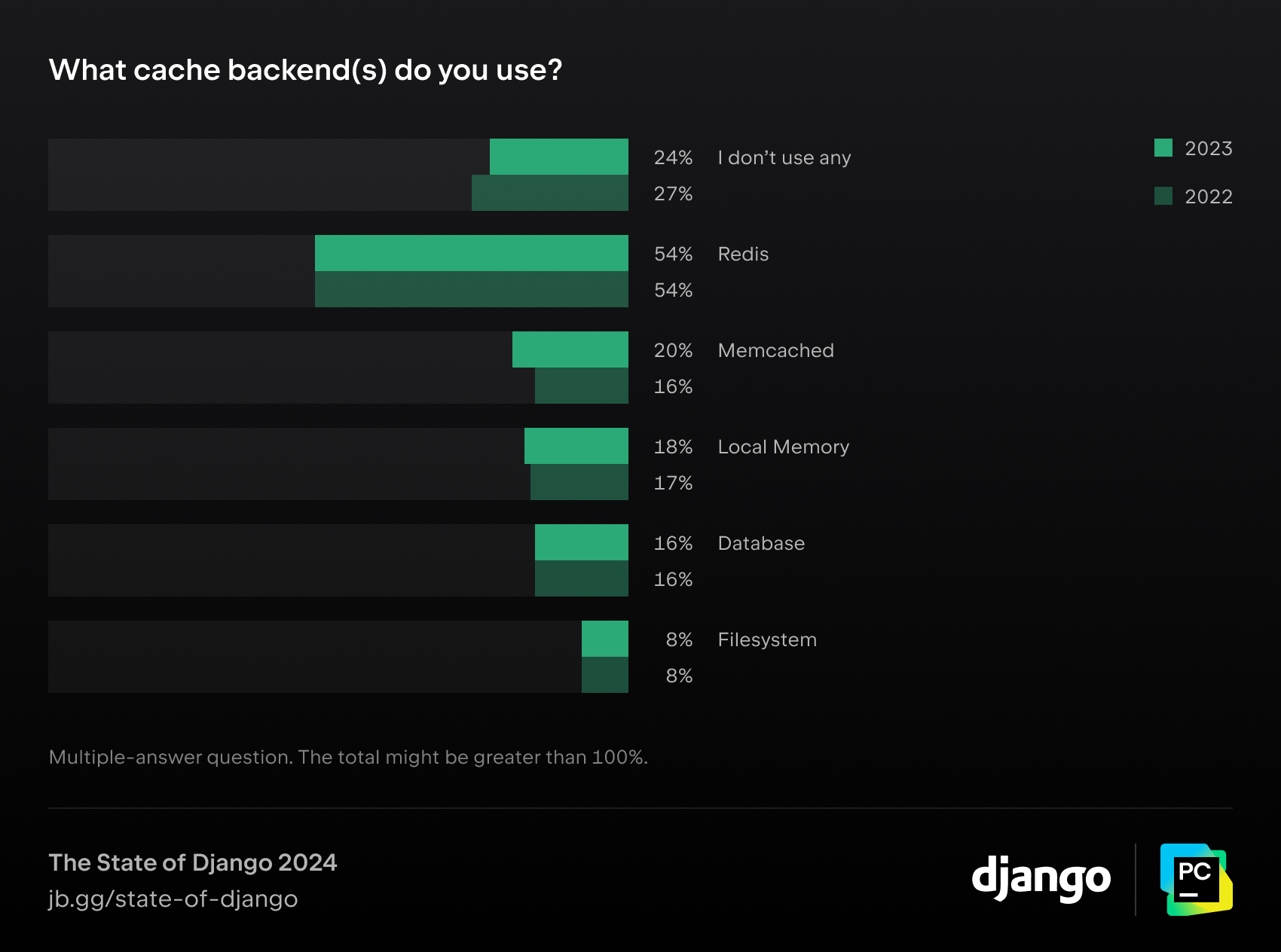
On the caching front, Redis remains the go-to solution (54%) for enhancing web app responsiveness, with Memcached (20%) also gaining traction.
Orchestration: More than 50% of Django developers use container orchestration
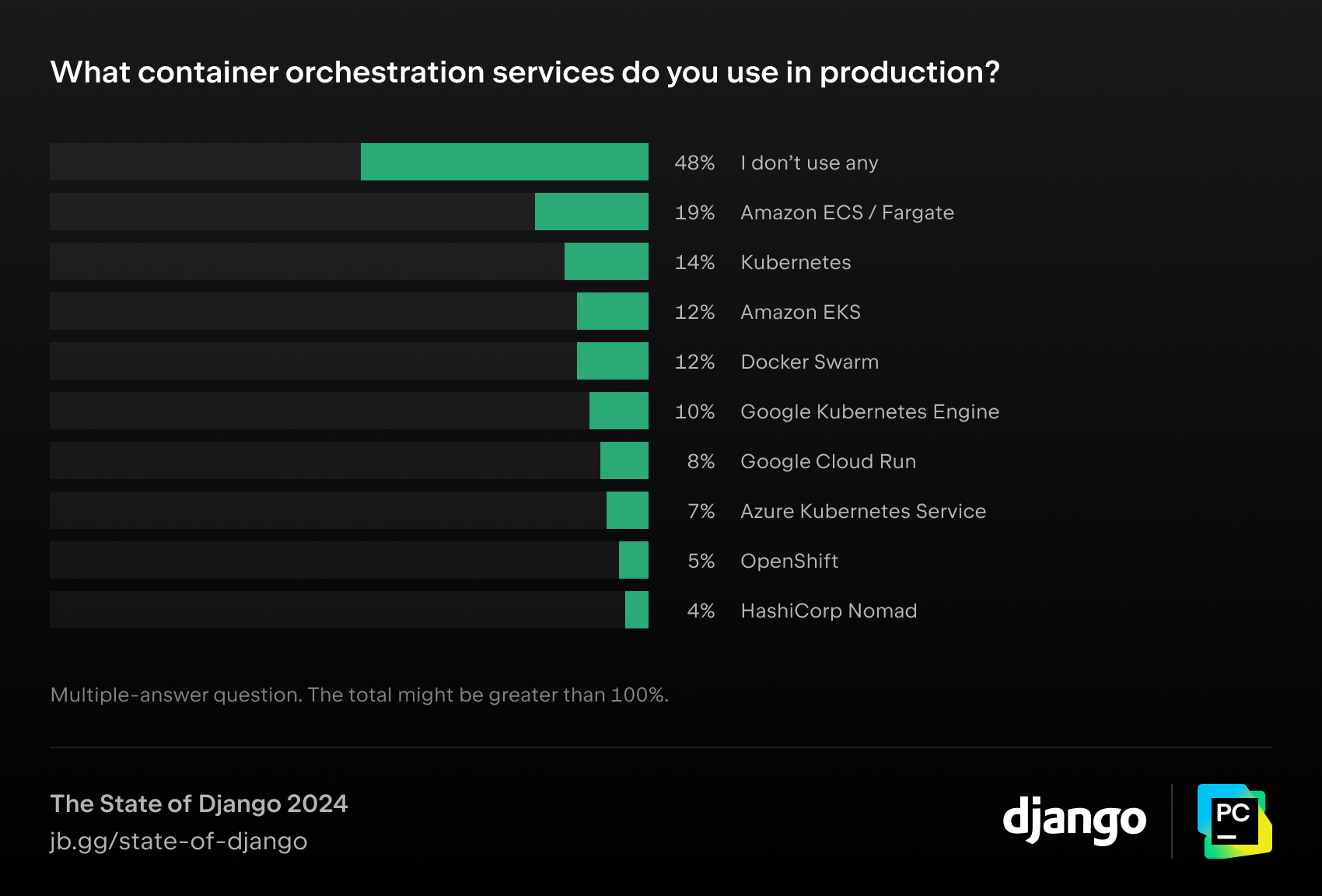
Among the favored services, Amazon ECS/Fargate (19%) leads by virtue of its ease of use and integration with AWS, making it a natural choice for developers in the AWS ecosystem.
Self-managed Kubernetes (14%) appeals to those seeking flexibility and control over their infrastructure, as well as the ability to easily migrate and share between private and public clouds. The popularity of Amazon EKS (12%) and Docker Swarm (12%) might be attributable to the balance they offer between manageability and scalability, catering to various deployment needs.
Deal with Kubernetes infrastructure? Read this guide on how to deploy Django apps in Kubernetes.
CI systems: GitHub Actions is leading the industry
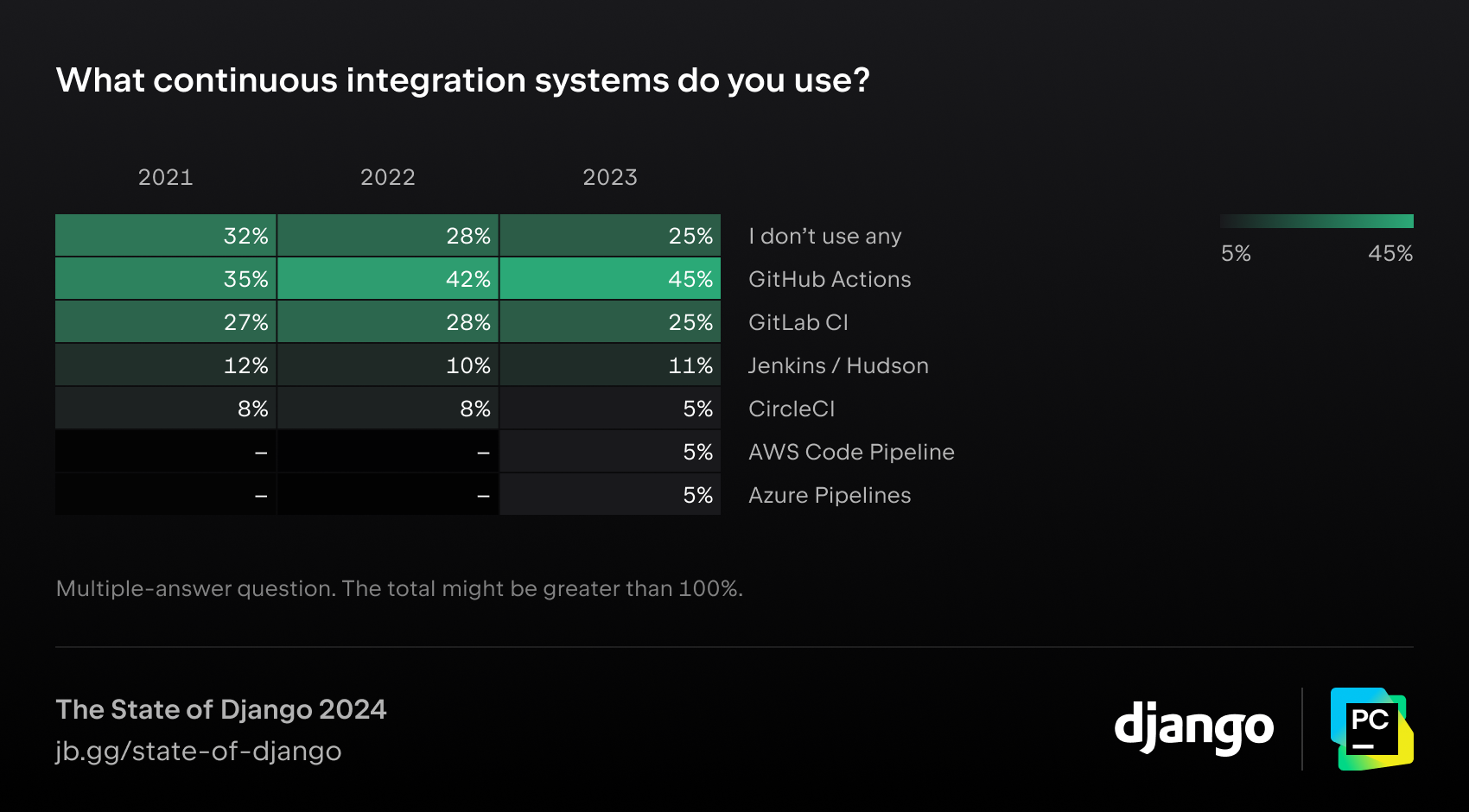
GitHub Actions’ growth (45% in 2023 compared to 35% in 2021) in the CI field highlights its convenience for developers who already use GitHub for source code management. Its simplicity, leveraging straightforward YAML files for pipeline management, makes it an accessible and efficient tool for automating software workflows directly within GitHub’s ecosystem. Moreover, it offers the flexibility of using custom hardware configurations that meet your needs with enough processing power or memory to run larger jobs.
IaC: Infrastructure as code is used by 39% of Django developers
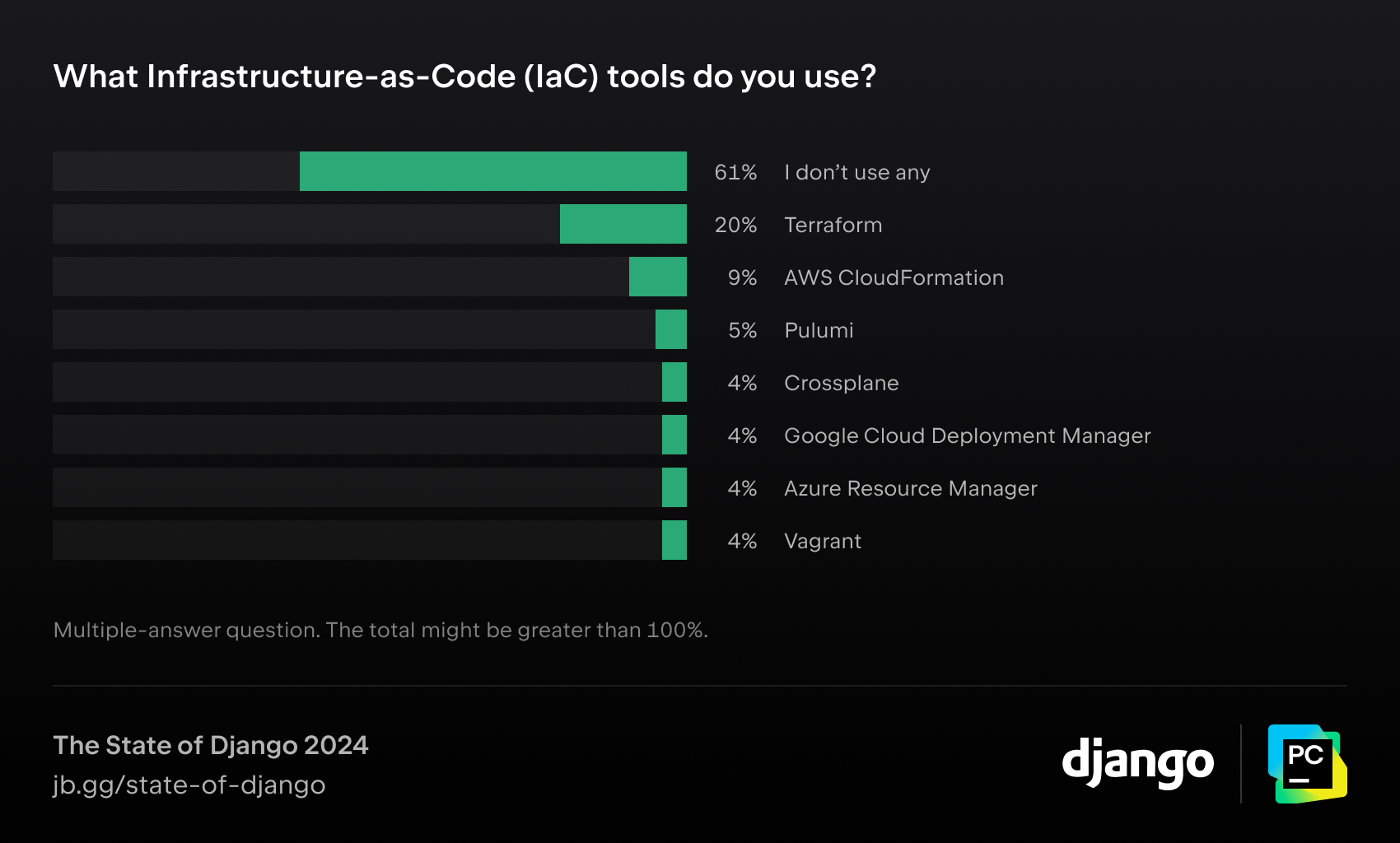
The use of infrastructure as code solutions by 39% of respondents underscores a growing trend towards automation and infrastructure management through code. For larger projects, IaC can ensure more reliable, repeatable, and scalable infrastructure setups. Terraform is the most commonly used infrastructure as code provisioning engine, with 20% of all respondents preferring it over the other options.
Interestingly, an open-source solution, Pulumi, was chosen by 5% of the respondents. The reason for this could be the fact that, right from its inception, Pulumi has offered the flexibility to use any programming language for managing infrastructure. This makes Pulumi widely accessible to developers and DevOps engineers from any background. Terraform began offering a similar option via a CDK in 2022.
Insights based on Django developers’ jobs and experience
Django learning resources
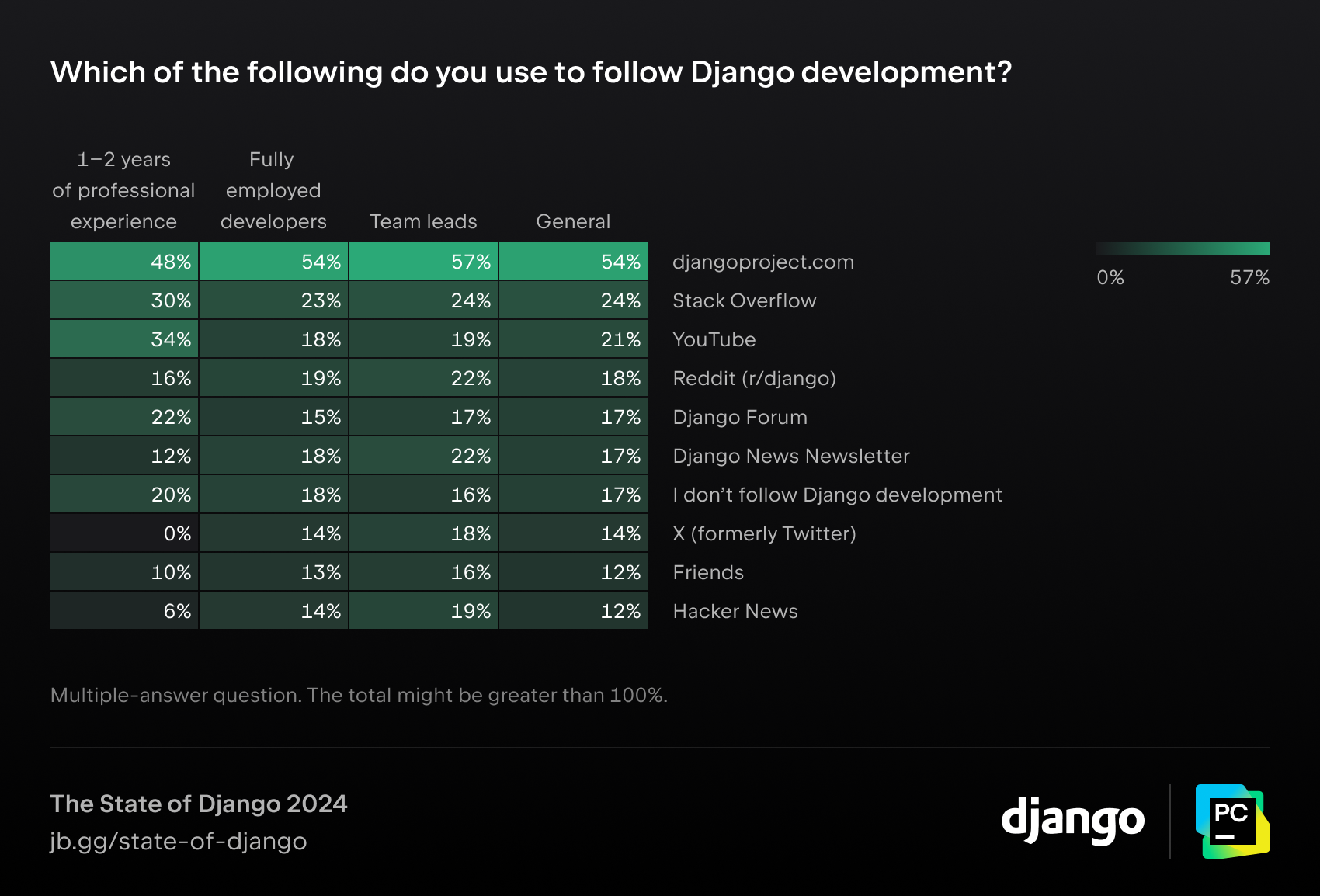
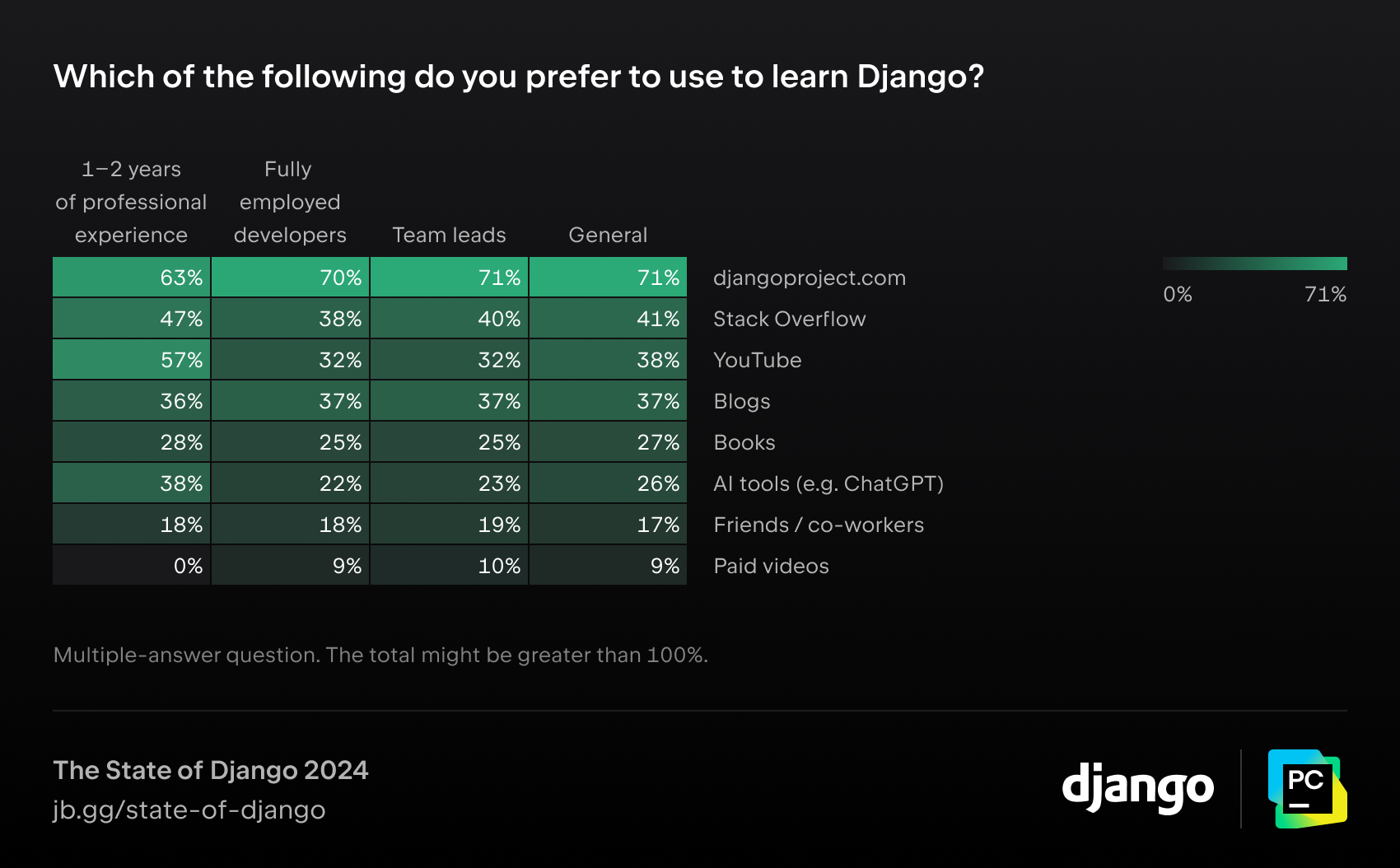
Fully employed developers watch less YouTube to learn Django (32% vs. 39% on average) and use fewer AI tools for this purpose (22% vs. 25% on average).
Among team leads, the Django News newsletter, HackerNews, Reddit, and even X (formerly Twitter) are more popular methods of staying up to date with Django developments. They even report learning more often from their friends (16% vs. 11% on average).
Junior professionals use YouTube and StackOverflow much more often for both educational purposes and to keep abreast of developments in the Django ecosystem. When it comes to their preferred learning method, they tend to use new AI tools more often than their senior colleagues (38% vs. 25% on average).
Miscellaneous
- Fully employed Django developers are more likely to use Django only for work (23% vs. 17% on average).
- The core component that team leads and fully employed developers as a group favor most is the possibility of migration, with their less preferred components including authentication, templates, and even class-based views.
- As their main editor, team leads tend to prefer PyCharm (31% vs. 29% on average) and Vim (12% vs. 7% on average) to VS Code (31% vs. 29% on average).
Start developing Django apps with PyCharm
Do you work with Django? PyCharm is the best-in-class IDE for Django. Code faster with Django-specific code insights, code completion, and highlighting. Navigate across your project easily. Connect to your database in a single click, and work on TypeScript, JavaScript, and other frontend frameworks. PyCharm also supports Flask and FastAPI out of the box.
Survey demographics
After filtering out duplicate and unreliable responses, the data set includes around 4,000 responses collected between September and October 2023.
Regional distribution
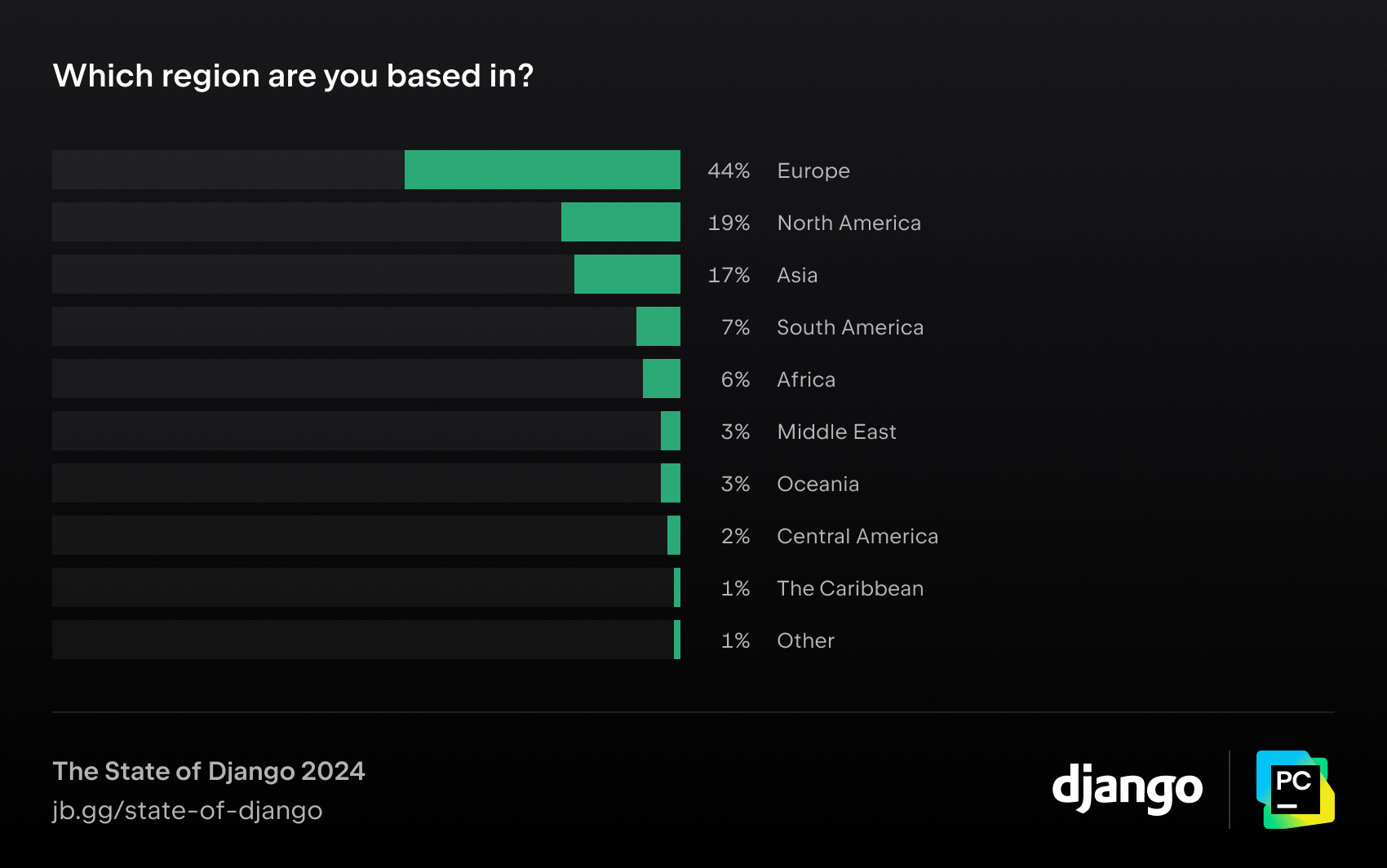
44% of respondents are based in Europe, 19% in North America, and 17% in Asia.
Age distribution
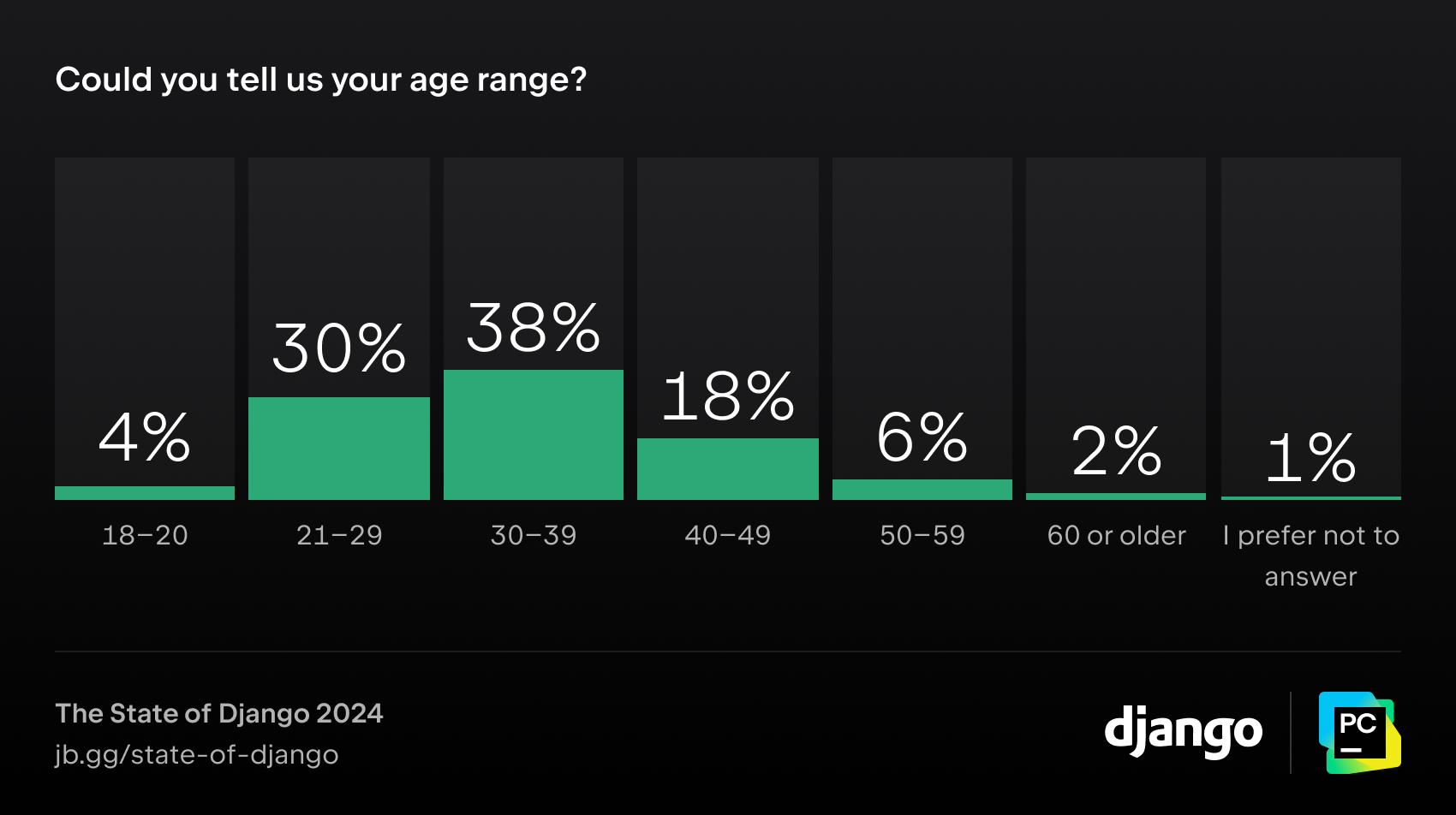
Most of the respondents are in the 21–49 age range. 38% of all respondents are aged 31–39, while 30% are aged 21–29.
Professional coding experience

The majority of respondents have been coding professionally for 11+ years. 24% of the survey participants have 3–5 years of professional coding experience, and 19% have worked as professional developers for 6–10 years. Those who have been developing professionally for less than two years represent another 25% of the survey respondents.
Job roles
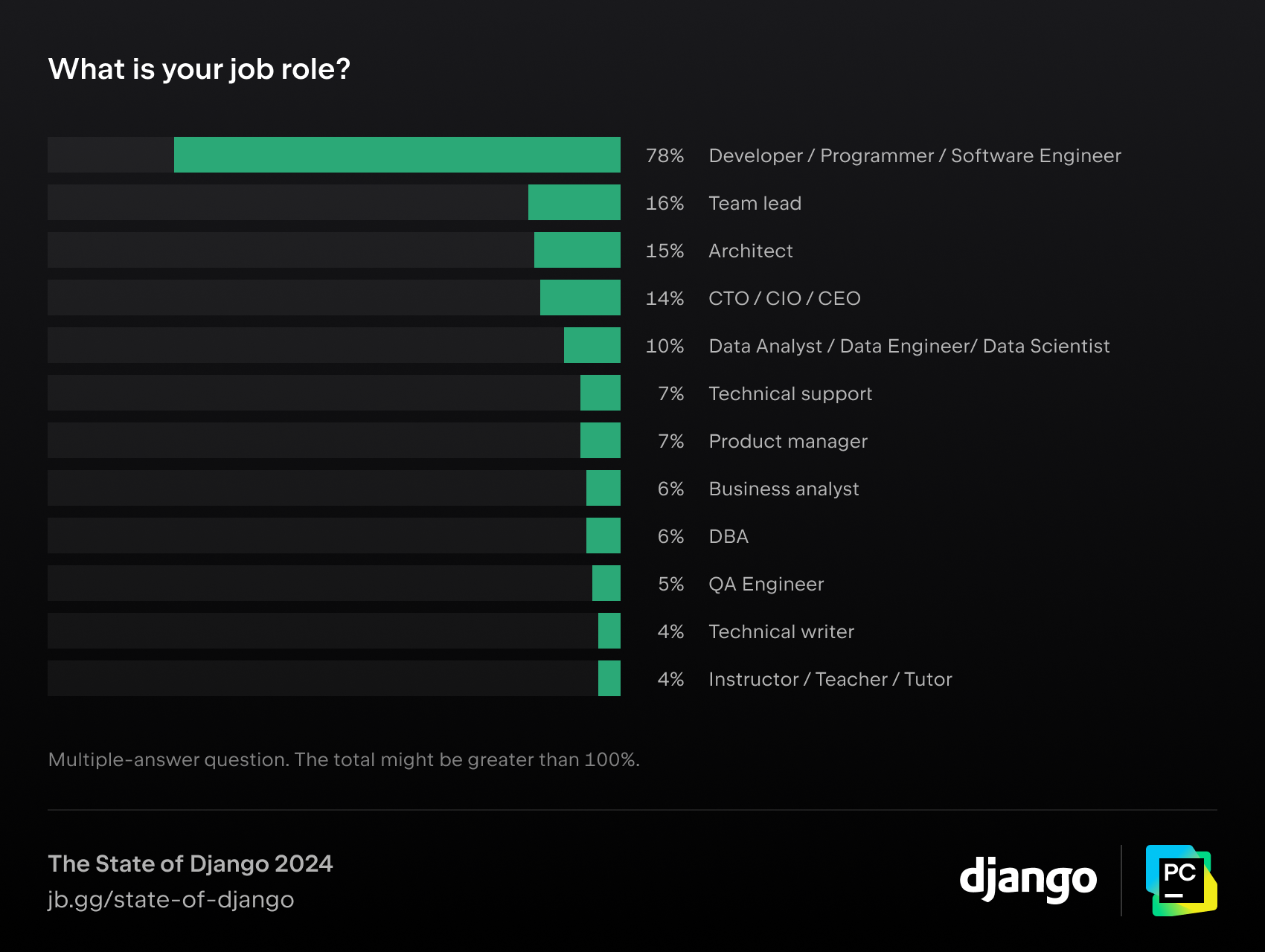
79% of respondents stated that their job roles include development/programming or software engineering. 16% of respondents are team leads. 10% of the respondents stated that their job includes data analysis, data engineering, or data science.
The data set includes responses only from official Django Software Foundation channels. The responses were collected through the promotion of the survey on official Django channels, such as djangoproject.com and the DSF’s X (formerly Twitter) account, without the involvement of any JetBrains channels. In order to prevent the survey from being slanted in favor of any specific tool or technology, no product-, service-, or vendor-related channels were used to collect responses.
Want to learn more? Explore the Django Developers Survey 2023 to see the full survey data.
Subscribe to PyCharm Blog updates








